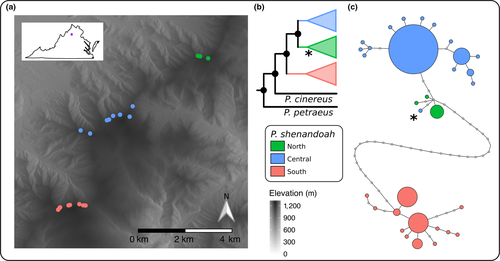North-facing slopes and elevation shape asymmetric genetic structure in the range-restricted salamander Plethodon shenandoah
Abstract/Summary
Species with narrow environmental preferences are often distributed across fragmented patches of suitable habitat, and dispersal among subpopulations can be difficult to directly observe. Genetic data collected at population centers can help quantify gene flow, which is especially important for vulnerable species with a disjunct range. Plethodon shenandoah is a Federally Endangered salamander known only from three mountaintops in Virginia, USA. To reconstruct the evolutionary history and population connectivity of this species, we generated both mitochondrial and nuclear data using sequence capture for all three populations and found strong population structure that was independent of geographic distance. Both the nuclear markers and mitochondrial genome indicated a deep split between the most southern population and the combined central and northern population. Although there was some mitochondrial haplotype-splitting between the central and northern populations, there was complete admixture in nuclear markers. This is indicative of either a recent split or current male-biased dispersal among mountain isolates. Models of landscape resistance found that dispersal across north-facing slopes at mid-elevation levels best explain the observed genetic structure among populations. These unexpected results highlight the importance of landscape features in understanding and predicting movement and fragmentation of salamanders across space.
Publication details
| Published Date: | 2019-04-16 |
| Outlet/Publisher: | Ecology and Evolution |
| Media Format: |
ARMI Organizational Units:
Northeast - BiologyTopics:
Species and their EcologyPlace Names:
Shenandoah National ParkKeywords:
ecologyEndangered Species Act
gene flow
genetics
management

